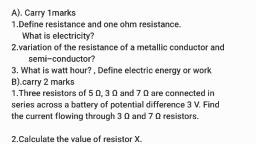Question 2 :
Shivam went for buying a CFL from D-mart, what safety mark he should look for?
Question 3 :
An electric fuse used in households works on which principle of:<br/>
Question 4 :
Two resistance thermometers are made, one of the platinum wire and the other of germanium wire. The resistance of both the thermometers are equal at room temperatures. Now the two resistance wires are connected to a battery. The two resistance wire are heated to 100$^0$C. The potential drop in the two resistance is measured. Which of the following statements is correct? 
Question 5 :
A typical thermistor can easily measure a change in temperature of the order of
Question 6 :
<span class="wysiwyg-font-size-small"><span class="wysiwyg-font-size-small"><p class="wysiwyg-text-align-left">The two surfaces A and B are at the same potential and separated by a distance $r$. The work done in carrying a charged particle ($q$) from A to B will be:</p>
Question 7 :
The temperature of a conductor is increased. The product of resistivity and conductivity:<br/>
Question 8 :
In general, the resistance to electric current of a material; in particular, the degree to which a material resists the flow of electricity is called<br>
Question 9 :
Constantan wire is used for making standard resistance, because it has
Question 10 :
When we pay for our electricity bill, we are paying for the:
Question 11 :
An electric bulb of $60\ W$ is used for $6\ hrs/day$. Calculate the units of energy consumed in one day by the bulb.
Question 12 :
With the increase in temperature, the ratio of conductivity to resistivity of a metal conductor:<br/>
Question 13 :
Two wires of Aluminium have same weight and have lengths of 10m and 20m. Their resistances are in the ratio.<br/>
Question 15 :
From below which are the applications of heating effect of electric current?<br>
Question 17 :
The cells are joined in parallel to get the maximum current when
Question 18 :
Taking the resistivity of platinoid as $3.3 \times 10^{-7}  m$, find the resistance of $7.0 m$ of platinoid wire of average diameter $0.14 cm$. 
Question 19 :
As the temperature of a conductor increases, its resistivity and conductivity change. The ratio of resistivity to conductivity<br>
Question 20 :
Assertion : The resistance of a milliammeter isgreater than that of ammeter<br>Reason : Shunt resistance in case of amilliammeter is more than that of ammeter<br>






















